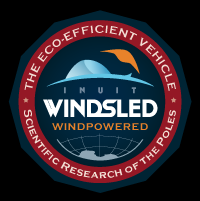Windsled Inuit
- wiki/WindSled
- https://greenland.net/windsled/ws/
- https://greenland.net/windsled/
- https://www.linkedin.com/company/greenland-net/
- https://greenland.net/windsled/wp-content/uploads/2014/04/ATT00049-2.jpg
- https://en.wikipedia.org/wiki/Polynya polyna
- https://en.wikipedia.org/wiki/Sastrugi sastrugi
- WingMill as Polar Energy Wind Tech (topic)
kPower Windsled Concept
Ideal kPower market, not crowded, good wind:
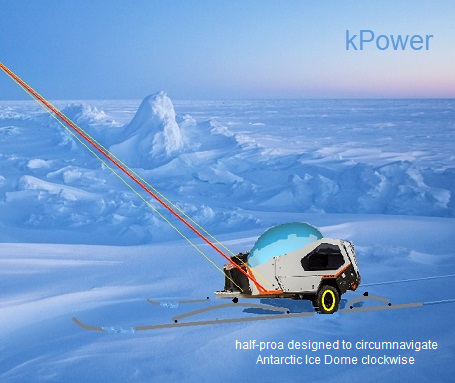
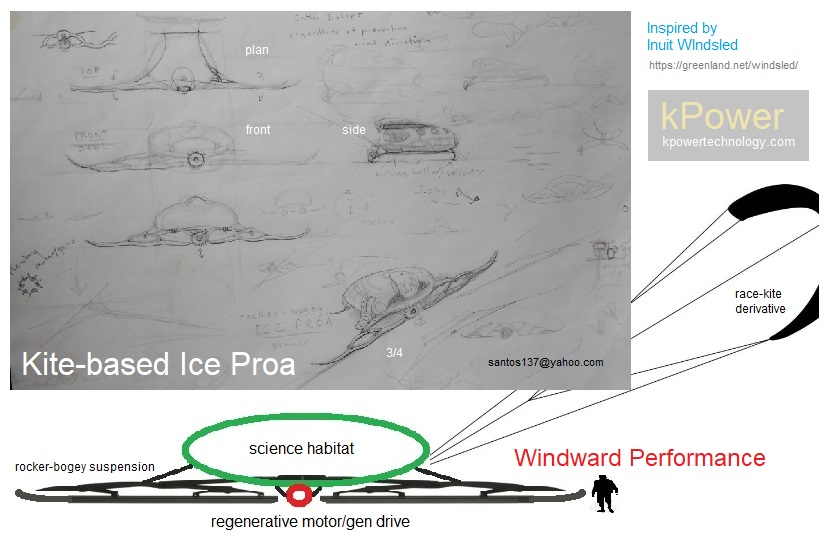
Hello Dave, thanks so much for all these inputs (and Marco's). We are in the process of "digesting" them :)
I believe your ideas could very well fit in for windsled’s mid term planning (after the big Antarctic campaign):
We were just about to undergo this 7K km Antarctic circumnavigation expedition in 20/21, tying in all major east Antarctic plateau research stations (check attached), but, of course, it has been pushed back to 21/22 due to these unfortunate CV circumstances we are all enduring.
In any case, the agenda was supposed to look like this:
DATES Official presentation (with media) 1st October 2020
Departure Europe 1st November 2020
Return to Europe 25th February 2021
And the itinerary will be this one:
Novolazarevskaya Station 70° 46′ 36.34″ S, 11° 49′ 20.48″ E
South Pole, Amundsen-Scott station, elevation 2635 m, 89° 59′ 51.19″ S, 139° 16′ 22.
Concordia station 3233 m, 75° 5′ 59.21″ S, 123° 19′ 55.
Vostok station 3488 m, 78° 27′ 50″ S, 106° 50′ 15.25″
Dome A 4093 m, 80° 22′ 0″ S, 77° 21′ 0″ E
Dome F 3810 m
Novolazarevskaya Station
At arrival windsled will have a temp of -60 deg C, and going towards a more manageable -35 deg C as they head to the South Pole. Less S&T projects will be carried this time due to the complexity of the campaign and the distance involved.
In the interim, I guess we can develop!
Pls all take extreme precautions with the CV virus situation we have at hand.
Cheers,
Carin Eve Cole
The Inuit WindSled Project
Science & Technology Programs Coordination
00 (34) 650 084 850-Madrid, Spain. Skype: Eve Cole
Sustainable Polar Science at: https://greenland.net/
More notes about AWE-driven ice cap conservation-
- Many of the geoengineering dynamics can be scale-modeled at lab benchtop scale. Great student activity.
- Ironically, heat has its uses, like tunneling refrigerant channels in ice. Meltwater is a sort of ready-to-use concrete. Summer solar gain is the most available heat, while winter cold gain is the primary goal.
- Pump out brine warm front eroding the submerged glacier face, supercool brine in polymer tubes on the surface, to return to glacier face front for direct cooling.
- Water freezes out of still saltwater, with brine collecting at the bottom of a reservoir. Brine drains from new sea-ice, distilling it.
- 290gr/kg salt to H2O looks optimal for thermal transport.
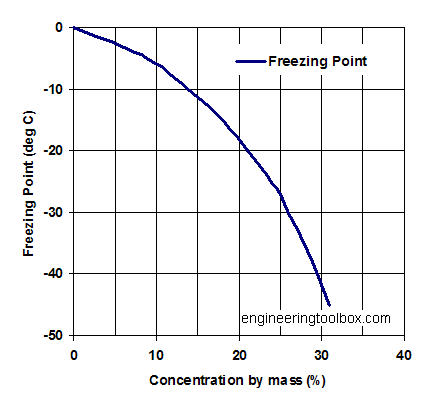
- Pinning large ice shelfs is a powerful technique, because a single pin can jam a large ice expanse. We well understand this mechanism, since natural underwater prominences are well known to pin ice. Ice is the likely sole structural pin basis, the most suitable geological (mineral solid) and ecological material.
- Ice cap surface meltwater that finds its way deep carries down heat into the ice. Damming up melt sinkholes as they form keeps this heat on the surface to radiate and convect away, and meltwater can then refreeze.
- Katabatic down slope winds can blow snow out to sea. Snow fences or berms could accumulate this snow at the edge of ice-caps and shelves, reversing loss in the best case.
- Supercooling water or brine can be done instantly by spraying in cold air. No heat-exchanger plumbing needed.
Another possible kite-power method is to pump up or divert meltwater undermining the Greenland cap, to spread it out for refreezing in the winter. Instead of plowing, perhaps swales and dams (and shelters) could be frozen into place by pumping meltwater.
Windsled probably already knows the scientists that can judge the required ice dynamics. In principle, the wind offers enough energy for vast geoengineering projects, and the AWE community can provide impressive theoretic numbers to the mix.
ICC- Ice Cap Conservation, a starting set of theoretic methods, with power kite networks as a promising basis. Its an open question if Ice Cap Loss can be reversed by any in-place intervention. Other benefits may include stabilizing the Gulf Stream from meltwater cold. This may be a multi-century challenge.
===============================
April 5, 2020, post by Carin Eve COLE
And will discuss these ideas with the team, to get back to you ASAP on it.
thanks again!
=========
April 5, 2020, post by Dave Santos
To conserve Ice Caps consider Contour Plowing slopes by kite sled to closely catch melting ice by day, that refreezes by night, greatly slowing run-off to the sea. Keep ice upslope as long as possible.
A large kite sled could plow 100 miles a day or so, to catch huge amounts of surface melt over a summer. This intervention by itself might tip the balance to preserve icecaps. This could be the paying basis of Ice Kite Civilization, the world sends food and pays for operations.
The fast changing ice cap surface is not conservable as such. Scratching it to preserve it could create new fossil layers marking where the intervention was done.
Schematic Ice Cap Concept (actual catchment furrows would be widely spaced on gentle slopes)-
TC - Stopping the flood: could we use targeted geoengineering to mitigate sea level rise?
See images in the article.
========
April 5, 2020, post by Carin Eve COLE
This is great thank you Dave!
have you seen this?
Two audacious plans for saving the world's ice sheets
and concerning ice dynamics:
Princeton University and the glaciology department is mentioned in this link and I know some scientists up at the laboratory and people at the Corporate engagement/ Foundation relations office...
Im sure they would be interested :)
Other folks also like East Grip in Greenland working on the NEGIS (north eastern greenland 600 km ice stream)...also
Ed adds links:
> sensitivity of the Northeast Greenland Ice Stream to Geothermal Heat
> IMAGE
Ed adds article:
> EastGRIP - The East Greenland Ice-core Project
> IMAGE
> https://geosciences.princeton.edu/research/climate-science
---------------------------------
Dave Santos adds:
Here is another key reference- Geoengineer polar glaciers to slow sea-level rise
AWE is definitely the vastest, cheapest, and most sustainable energy source available in remote Polar regions. WindSled has even proved this in practice. Enough kite actually removes excess atmospheric energy. Impeding catabatic warming is possible.
Drilling and operating tunnels for supercooled brine is a huge challenge. Presumably, winter cold could do the super-cooling in large shallow ponds, but the brine must not be allowed to contaminate freshwater ice.
This seems to be a key reference for coastal glacier ice-shelf conservation by "pinning" and damming-
TC - Stopping the flood: could we use targeted geoengineering to mitigate sea level rise?
See images in the article.
=========================
Contour Plowing to Conserve Ice Caps?
Another possible kite-power method is to pump up or divert meltwater undermining the Greenland cap, to spread it out for refreezing in the winter. Instead of plowing, perhaps swales and dams (and shelters) could be frozen into place by pumping meltwater.
Windsled probably already knows the scientists that can judge the required ice dynamics. In principle, the wind offers enough energy for vast geoengineering projects, and the AWE community can provide impressive theoretic numbers to the mix.
ICC- Ice Cap Conservation, a starting set of theoretic methods, with power kite networks as a promising basis. Its an open question if Ice-Cap Loss can be reversed by any in-place intervention. Other benefits may include stabilizing the Gulf Stream from meltwater cold. This may be a multi-century challenge.
I see you are greatly inspired, what a bunch of terrific ideas, ice cap countour plowing too! And I agree totally with all of them. At the least, I want to go do some melt-water channel plugging and lots of dark snow ash-layer scraping and removal (as in a big icy back yard :), to help increase albedo to subsequently reflect that radiation, or lots more, back into space again...
Carin Eve Cole
The Inuit WindSled Project
Science & Technology Programs Coordination
00 (34) 650 084 850-Madrid, Spain. Skype: Eve Cole
Sustainable Polar Science at:
Colonizing Ice Caps With WindSled Tribes?
=== early draft statement ===
A paradox of our time is that kite-power (AWE) is opening up the ice caps, even as they begin to melt. With enough AWE, we can be "Polar Polynesians", if you will. Kite sleds on the major ice caps could become as big as ships, or form large fleets. An new kind of civilization could develop.
The key to colonizing ice caps en masse with WindSled Tribes is a sustainable economic basis. Ecotourism is not ideal unless "tourists" do productive scientific or logistical support. Initially, there is a bit of real exploration left, and a lot of pioneering operational research. KGM and kPower are helping develop electrical AWE concepts.
There are possible eco-services, like combating soot-darkened ice by scaping, or damming or plugging meltwater drains lubricating glacial movement. Maybe even regenerating ice by spreading meltwater back out to refreeze. Kites could in principle do the work, but its unknown how useful or just how eco work may be.
Contour plowing ice-capped slopes to catch melting ice by day, which refreezes by night, greatly slowing run-off: a large kite sled could plow 100 miles a day or so, to catch huge amounts of surface melt. Keep the ice upslope as long as possible. This intervention by itself might tip the balance to preserve icecaps. This could be the paying basis of Ice Kite Civilization, the world sends food and pays for operations.
Operating an Inuit WindSled on the Caps is already proven. The bare capital cost of sled, rig, and kit is low, with a single polar delivery to get started. The lifecycle problem is an effective food import supply chain. Passively frozen food eases the diet challenge.
[to be continued]
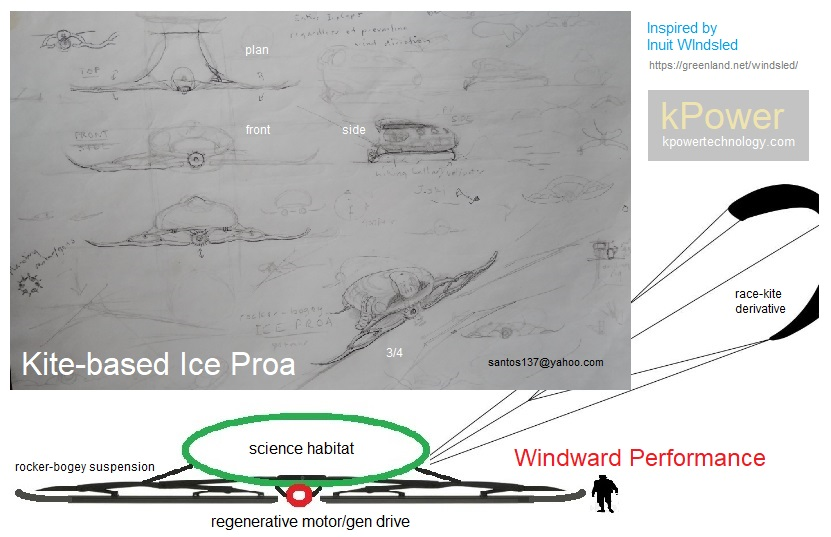
============
Glaciers and Icecaps
The design principle for windsleds is similarly adjustable ice-blades scaled-up. Common Polar surfaces will be crusty ice, snow, slush, and more rarely smooth ice. A long conventional ski or snowboard metal edge and HDPE surface, with ice-blades in reserve, will serve.
v
ExplorersWeb.com- "Now this is kiting"; Polar Exploring with Inuit Windsled
Most detailed coverage yet of AWE's historic polar nomadic homesteads, having already covered many thousands of km, with millions to go. Solo adventurers also use kites these days. Adding electrical generation to the NPW traction power is currently under development. That news soon-
Now, This is Kiting!
Inuit Windsled Program integrating into AWE Community
Having proven itself as a kite-based solution in its Polar domain, the Windsled concept and team will be featured at AWEC2019, bringing the venerable NPW into prominence in the midst of all the other wing types-
AWE alternative to conventional logistics in Polar Regions
Pioneering AWE homesteading on land, ice, or sea is proving far more dynamic and nomadic than the previous wind model of fixed remote homesteading with a tower-based turbine.
Windsled Diary- New Kite Lifestyle being perfected
Amazing progress of the newest most sustainable way of Polar exploring, by means of kites, with more than two tons of habitat pulled over 200km/day, up to 35km/hr with as little as a 10m2 kite or as big as 150m2.
Lots of great operational details being worked out. As predicted by kPower, kite-quiver practice is finding power kites last many years in like-new condition, but watch out for suddenly rising wind conditions that can cause too much kite to be flying, and then it gets rather dramatic.
Rag-and-String is real kite power; more hands-on sailing-in-the-sky than robotic drones. A single Windsled or Shipkite voyage clearly harvests far more AWE than all existing high-complexity prototypes put together.
Expedition diary 2018/2019
